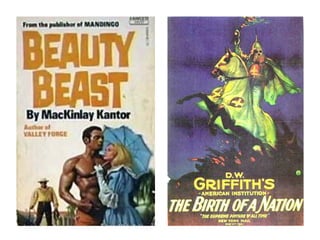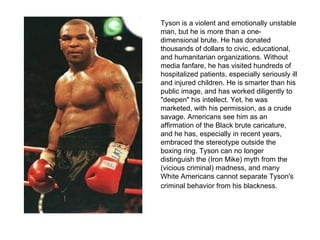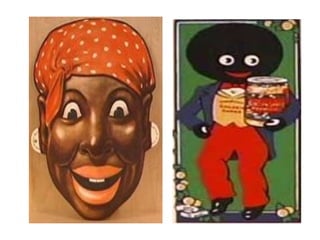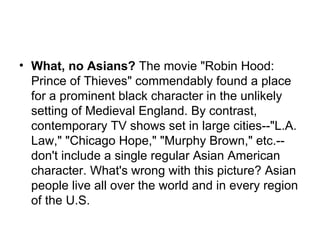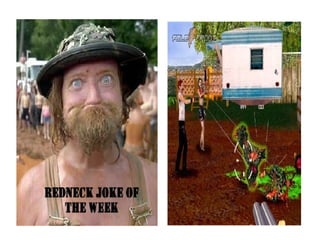Ethnicity
- 1. I am an invisible man... I am invisible, understand, simply because people refuse to see me. Ralph Ellison, Invisible Man
- 4. Tyson is a violent and emotionally unstable man, but he is more than a one-dimensional brute. He has donated thousands of dollars to civic, educational, and humanitarian organizations. Without media fanfare, he has visited hundreds of hospitalized patients, especially seriously ill and injured children. He is smarter than his public image, and has worked diligently to "deepen" his intellect. Yet, he was marketed, with his permission, as a crude savage. Americans see him as an affirmation of the Black brute caricature, and he has, especially in recent years, embraced the stereotype outside the boxing ring. Tyson can no longer distinguish the (Iron Mike) myth from the (vicious criminal) madness, and many White Americans cannot separate Tyson's criminal behavior from his blackness.
- 9. The standard for mammy depictions was offered by Harriet Beecher Stowe's 1852 book, Uncle Tom's Cabin . The book's mammy, Aunt Chloe, is described in this way: A round, black, shiny face is hers, so glossy as to suggest the idea that she might have been washed over with the whites of eggs, like one of her own tea rusks. Her whole plump countenance beams with satisfaction and contentment from under a well-starched checkered turban, bearing on it; however, if we must confess it, a little of that tinge of self-consciousness which becomes the first cook of the neighborhood, as Aunt Chloe was universally held and acknowledged to be.
- 13. Tee-shirts with the words, "Ain't RACIST Just Never Met a NIGGER I liked," or "Martin Luther Coon" are found at many White power sites. Many of these sites also include "nigger jokes" and anti-Black cartoons. These cartoons are vulgar and portray traditional anti-Black stereotypes. Odinslounge , a self-described "White Racialist Page," has many racist and anti-Semitic cartoons. There is also a skinhead website which has anti-Black and anti-Jewish cartoons. The cartoons on these websites are often reproduced on posters.
- 14. Asian racial features, names, accents, or mannerisms as inherently comic or sinister. Because distinctive Asian characteristics are less common in the United States, movies and TV shows often fall back on them for quick and easy gags or gasps. For example, the thick accent of the goofy Chinese exchange student in "Sixteen Candles"--who is given the sophomoric name "Long Duk Dong"--is used for cheap laughs, while the numerous Fu Manchu movies have presented the Asian character's culturally distinctive speech and appearance as emblems of unfathomable evil.
- 17. Asian Americans as foreigners who cannot be assimilated. Because they are racially and culturally distinctive from the American mainstream, Asian people have been widely seen as unable to be absorbed into American society. According to this view, anything Asian is thus inherently "alien" to America. This is reflected in the media by the disproportionate number of unacculturated Asian characters speaking with foreign accents. Acculturated Asian American personalities have sometimes even been portrayed as unassimilated (such as radio comedians satirizing Judge Lance Ito with an inappropriate foreign accent). This portrayal ultimately suggests that anything Asian must remain apart from American society. However, the descendants of Asian immigrants have acculturated themselves not only to the United States but also to non-Asian societies throughout the world: Europe, Australia, Latin America, Africa.
- 18. Asian cultures as inherently predatory. For decades, Americans have viewed Asian immigrants as "taking" from this country without giving anything back. This perception was reinforced by early laws making it difficult for Asians to immigrate and impossible for them to become naturalized citizens. Although these laws have since been repealed, the image of the Asian as alien predator still infuses popular media. In the movie "Falling Down," for example, the white main character accuses a Korean grocer of draining American resources without bothering to fit into American society. This accusation "justifies" the lead character's destruction of the Korean's grocery store. Similarly, the movie "Rising Sun" portrays Japanese businessmen taking over American industry by murder and deceit. And countless movies and TV episodes have portrayed Chinatowns as breeding grounds of crime.
- 19. Asian Americans restricted to clichéd occupations. Asians and Asian Americans make their living in a wide array of professions, but too often, Asian American professionals are depicted in a limited and predictable range of jobs: restaurant workers, Korean grocers, Japanese businessmen, Indian cab drivers, TV anchorwomen, martial artists, gangsters, faith healers, laundry workers, and prostitutes. This misrepresents the diversity of the Asian American work force.
- 20. Asian male sexuality as negative or non-existent. Although Asian women are frequently portrayed as positive romantic partners for white men ("Sayonara," "The World of Suzie Wong," ad infinitum), Asian men are almost never positively paired with women of any race. Western society still seems to view Asian male sexuality as a problem. Consequently, Asian men are usually presented either as threatening corrupters of white women or as eunuchs lacking any romantic feelings. For example, in the action movie "Showdown in Little Tokyo," the Asian villain forces himself upon a white woman and murders her before threatening the Asian female love interest. Predictably, the white hero kills the Asian villain and "wins" the Asian woman--while the hero's Amerasian sidekick is given no love life at all.
- 21. Asian women as "China dolls." Asian women are often portrayed as exotic, subservient, compliant, industrious, eager to please. While nicknamed the "China doll," "geisha girl," or "lotus blossom," this sexually loaded stereotype isn't restricted to Chinese or Japanese women. This portrayal is epitomized by the self-effacing title character of the opera "Madame Butterfly," but it can also be seen in works like "Teahouse of the August Moon" and "Tai-Pan."
- 22. Asian Americans as the "model minority." Upon hearing the Asian American community's concerns over media images, some producers have made a good-faith effort to create more positive portrayals. Unfortunately, some of these portrayals go too far in the other direction, depicting Asians as so flawless that they are robbed of any humanity. In particular, the image of Asian Americans as over-achievers with little emotional life (such as the Asian American classmate in the canceled TV sitcom "Pearl") can be just as confining and dehumanizing as any overtly negative portrayal. No one is calling for Asian characters to be sanitized of all shortcomings, just for them to be portrayed as well-rounded, relatable human beings.
- 23. Asianness as an "explanation" for the magical or supernatural. Asia is often used as a quick and convenient reason for something having magical or supernatural properties. For years, the radio hero "The Shadow" was said to have acquired his powers of invisibility from "the mysterious East." No further explanation was necessary. More recently, the Woody Allen movie "Alice" accounted for the magical powers of an elixir by having the white title character buy it from an Asian herbalist. Assumption: Asian cultures are so strange and unknowable that they can defy the physical realities of the Western world. Granted, Asian magic can sometimes be portrayed positively in fiction. But without more realistic images to provide balance, this other-worldly conception of Asia risks painting a mystifying and misleading picture of Asian cultures and Asian people.
- 24. What, no Asians? The movie "Robin Hood: Prince of Thieves" commendably found a place for a prominent black character in the unlikely setting of Medieval England. By contrast, contemporary TV shows set in large cities--"L.A. Law," "Chicago Hope," "Murphy Brown," etc.--don't include a single regular Asian American character. What's wrong with this picture? Asian people live all over the world and in every region of the U.S.
- 26. NEGATIVE STEREOTYPES POSITIVE / PATRONISING STEREOTYPES, OFTEN WITH SINISTER UNDERTONES INVISIBILITY


